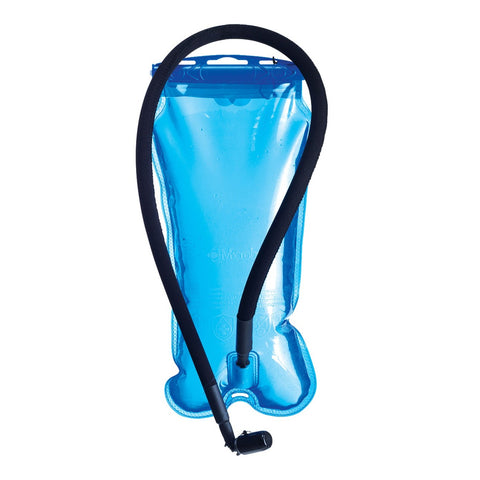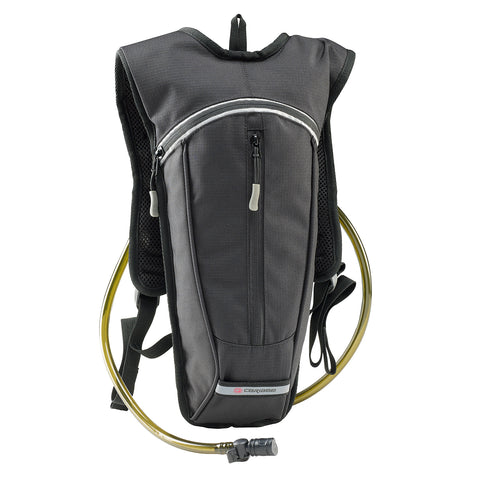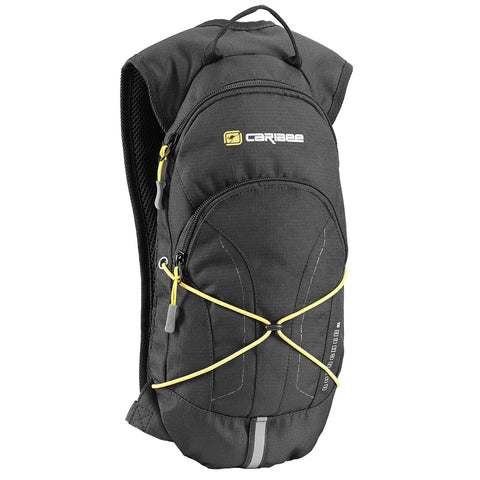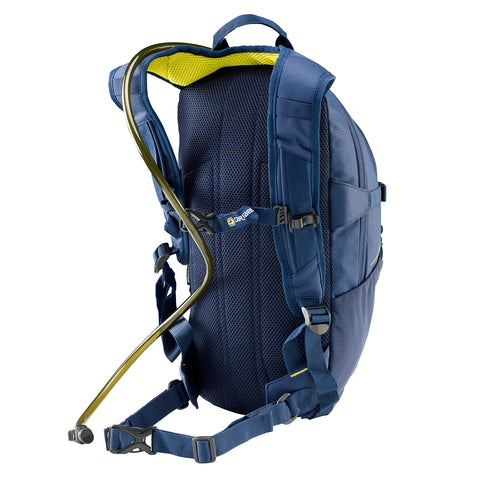
Hydration backpacks - what are they and what should I look for when buying?
Hydration backpacks have been designed to allow you to transport good amounts of water and liquids efficiently over rough terrain or long distances whilst keeping your hands free. To answer if they are worth it and what you should look for when buying a hydration backpack, read on.
Traditionally hydration backpacks are a small slim line design daypacks that holds a hydration reservoir, typically ranging from 1.5L up to 3L in size. They fit against your body and with the use of a sternum strap and sometimes a hip belt (if the size of the pack allows) they allow you to run, cycle, trek or traverse areas without carrying bulky water bottles.
Are Hydration backpacks worth it?
For bush walking or short hikes, you might as well carry a regular daypack, since there’s probably other gear apart from water that you want to carry, so best to grab a good backpack that has an option of adding a hydration reservoir. There are a number of Caribee daypacks that provide this feature, a hydration sleeve and outlet, these packs can also be used for every day use. To convert these packs to a hydration backpack, simply buy the daypack and add a hydration reservoir.
For trail running, its absolutely worth it, especially if you’re going to be out for an hour or more. When you’re out on a long trail run, you have to stay hydrated and that means you pretty much have to carry it yourself. When it’s even a little warm, a litre per hour is not an unreasonable rate of consumption (you probably want some electrolytes if you’re sweating that hard, too). Plus, training with an extra 2kg of water on your back helps build muscle.
If you’re running around the suburb or on a track, you won't need a hydration pack. At a track, you can bring whatever container you want and leave it trackside. In town, you may carry a small bottle, but chances are you’ll be able to find locations to grab a quick drink.
What is the best Hydration backpack for me?
Like clothing and footwear, the best hydration pack is the one that fits your body properly, has the features you want or need, is appropriately sized for your intended use and fits your budget.
Anybody can suggest a pack that they think is great because it works wonderfully them. It might not however be the right pack for you, so it is best to research packs based on cost, size, reservoir and availability.
Caribee sells a great range of hydration backpacks through Anaconda, BCF and Rebel. Also check out the full range of Caribee Hydration backpacks online at caribee.com
When it comes to running, hiking or cycling, especially over longer distances and in diverse terrains, having the right hydration pack or vest can significantly enhance your experience and performance. A crucial aspect of these accessories is pack capacity or the volume of goods they can accommodate. Depending on the distance and location of your activity, you might require extra layers of clothing, food, sunglasses, a headlamp, gloves, headwear, etc. The more gear you need to carry with you, the more space you will need in your pack. Caribee's range of hydration packs range from the small and compact Hydra 1.5L that is great for running and cycling through to the larger Condor Two or Razorbill Two that have room for all your gear and perfect for treks.
What to look for in a Hydration backpack purchase:
Reservoirs – 1.5L to 3L
Reservoirs, often referred to as hydration bladders, are available in multiple fluid capacities and provide a hose and bite valve system for ease of sipping water while on the move. These flexible, bag-like containers combine with their hose and bite valve system, allowing for effortless sipping without interrupting your stride. Reservoirs are particularly advantageous for long-distance or time scale activities where consistent hydration is vital. They typically range from 1.5 to 3 liters in capacity, providing ample hydration without the need for frequent refills.
Like all things, there are different levels of quality from entry level systems up to advance hydration reservoirs that have trick closing systems or reservoirs that can be frozen ready for hot days. Caribee offers both types of reservoirs, our 1.5L and 2L systems that we supplied with all our hydration backpacks apart from the Nuke 3L, are a great entry level reservoir that is made from soft touch TPU material that is BPA, Phthalate and PVC free. The reservoir has a low profile screw cap and high flow mouth piece all for an affordable price. This reservoir allows Caribee hydration packs appeal to both entry level and intermediate uses and it can be easily swapped out of the Caribee pack for most brands higher specification reservoir at any time.

Caribee’s 3L reservoir is a premium grade system. Made from PEVA material that is BPA, Phthalate and PVC free it’s innovative fold top reservoir with slide lock closure allows for quick filling and easy access for cleaning. The drink tube is insulated to help reduce water in the tube being affected by heat and has a Quick Release, non-leak, function making fitting and removal of the reservoir in your pack a simple process. The high flow mouth piece features a "bite" on/off flow function and mouth piece dust cover.
Finally, just like your toothbrush, you will need to replace the mouth piece of your hydration backpack from time to time. Hygiene along with general wear and tear will dictate this and replacement mouth pieces can be purchased direct from the Caribee website.
Size and Fit
Size and fit are an important factor when selecting the best hydration pack for you. A hydration pack that fits well is more than just a matter of comfort; it's a performance enhancer. An improperly fitting pack might rub and chafe, causing skin irritation as well as soreness and all-around discomfort. Like any article of clothing or footwear, the fit of a hydration system is personal and you may find it worthwhile to compare a couple of choices before you pick your perfect pack.
Price point
When seeking the ideal hydration pack, understanding the price range can help you make a well-informed decision. Prices for hydration packs can vary greatly based on factors such as brand, features, materials used, capacity and the quality of the hydration reservoir included. It's important to find the right balance between your budget and the features that align with your intended needs.

At the entry-level tier, hydration packs are designed to offer basic functionality for the casual runner. These packs in the Caribee range fall within the price range of $49 to $69, and provide an affordable option for those who require a hydration system without the need for extensive features or cost. Take a closer look at the Hydra 1.5L or Quencher 2L hydration backpacks by Caribee. Both are great entry level packs that are ideal for running and cycling and if you find you use the pack a lot, you van upgrade the reservoir easily.

Moving up to the mid-range options, you'll find hydration packs that strike a balance between quality, comfort and size. These options are well-suited for longer duration outdoor activities when storage is a factor and come with a price range that typically spans from around $79 to $99 in the Caribee range. Within this range, you can expect to find packs that offer a high spec’d pack compared to entry-level options, catering to the needs of more committed runners, hikers and mountain bikers.

Hydration on the work site and staying visible during outdoor activities is also very important. Caribee offers a high visibility hydration backpack that are used in mines, on work sites and recreationally by any people wanting to remain more visible whilst keeping hydrated. The Caribee Nuke is a high visibility hydration backpack supplied with a the premium 3L reservoir. These AS/NZS and ANSI approved hydration packs are available in Orange or Yellow with reflective D/N tape and a popular choice in Australian industry and with commuter cyclists looking to increase their visibility.

What about Hydration Vests?
Hydration vests differ to hydration backpacks by way that they are closer to a garment than a backpack. You wear them more like a typical vest and they tend to have pockets on the harness compared to a hydration backpack. There are pros and cons to hydration vests it just depends what application you are looking to use your hydration system for.
Many people start their hydration journey out with a hydration backpack, as styles like the Caribee Hydra 1.5L hydration backpack are relative affordable, perform well and give you a better understanding on the operation of a hydration pack and how often you will use a hydration system. The Caribee range of hydration backpacks are designed to fit most brands of hydration reservoirs, so if you plan on updating your reservoir to an intermediate or high specification reservoir, you can do this without having to change your backpack.
Pros and Cons of Hydration Vests
Basically you need to decide what is best for you, your body shape and your intended activity. We have put together some Pros and Cons of hydration vests to help you decide if a vest or a backpack is right for you.
Pro:
- Vests (if fitted correctly) tend to sit snug to your body and as a result reduces movement during activity.
- Vests tend to offer multiple pockets on the harness allowing you to carry more gels/fuels without having to stuff your pockets or wear a runner’s belt.
- While they tend to have the same number of adjustable straps, a hydration vest’s fit can feel more customizable.
- Hydration vests are ideal for running where there is greater potential movement of reservoir or backpack. Vests typically are not worn when hiking or cycling.
- Caribee has developed a hybrid running hydration vest/pack called the Coyote Runner with a 2L reservoir that takes the best bits of both hydration packs and vests and combines it in to one great product. This will become available Summer 2024/25.
Cons:
- Vests tend to be more complicated in their construction and as a result tend to cost more than their backpack counterparts.
- As the vests closely resemble a garment, they tend to be sold in multiple sizes, so choosing the correct size to fit your body shape may require a trip to the store rather than buying online to see if they fit.
- Vests can be more complicated to fit compared to a traditional hydration backpack with some styles having side and front adjustment points.
- Vests are popular with runners but less so with those hiking and cycling where the vest style garment can become hot and more restrictive of movement. Those mountain biking and trekking still tend to use hydration backpacks rather than vests.
